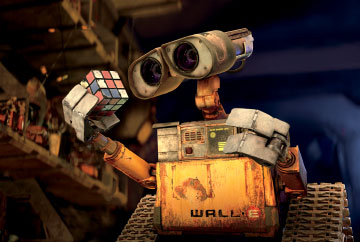 WwwaaaLLLLLL-Eeee
WwwaaaLLLLLL-Eeee! In the end, I can’t say I enjoyed it quite as much as
Brad Bird’s The Incredibles, and I really,
really wish it’d stayed in the melancholy
I am Legend/
Lars and the Real Girl groove of its first hour, rather than devolving into an
Idiocracy-type satire aboard Douglas Adams’
Starship Titanic. That being said,
Andrew Stanton’s ambitious, impressive WALL-E is definitely in keeping with the high standard we’ve come to expect from the Pixar gang, and in scope and theme alone I’d rate it above recent forays
Ratatouille,
Cars and
Finding Nemo. Part
Silent Running-ish environmental parable, part whimsical robot romance (
think Bjork, but you know, for kids!), and part trenchant political slapstick (note the Dubyaesque Fred Willard),
WALL-E fires on significantly more cylinders throughout than, say, your average
Dreamworks animation would even attempt. That the reach of
WALL-E‘s ambition ultimately exceeds its grasp in the second hour, when the movie becomes a much more conventional family flick, can’t be held too harshly against the film, I think. I wish
WALL-E had stayed Earthbound, in a way, but at least the little guy was reaching for the stars. (In any case, I expect
WALL-E has a metal, mortal lock on next year’s Best Animation Oscar.)
Bringing a literal meaning to the term “space opera”, WALL-E begins with — of all things — Michael Crawford of Phantom fame crooning a musical number from Hello, Dolly! (“Put on Your Sunday Clothes“), which we hear while traversing the more scenic localities in our corner of the cosmos. Eventually, the swooping camera keys in on our home planet, except it’s clearly surrounded by more satellite debris than seems atmospherically sanitary. As we come down to Earth, matters are worse: Our beloved Terra has become an arid, dusty wasteland, cluttered with decaying buildings, vacuous advertising, and skyscrapers made of garbage. Enter WALL-E (Waste Allocation Load Lifter — Earth Class), a goggle-eyed robot (of the No. 5, Huey, and Vincent persuasion more than Artoo) whose job it is to construct these towers of refuse and who happens to be — along with one solitary cockroach — the lone survivor of our-now abandoned civilization.
Loneliness does funny things to a droid. Over the centuries of isolation, it seems, WALL-E has developed something of a personality — he collects intriguing knick-knacks he finds amidst the trash, repairs himself with pieces of his defunct brethren, and endlessly watches what’s left of a deteriorating VHS copy of Hello Dolly!, honing his song-and-dance routine and his understanding of human rituals of affection in the process. Alas, his skills of courtship go wasted…until, one day, EVE (Extraterrestrial Vegetation Evaluator) literally drops out of the sky, with a gimongous rocket ship in tow. A sleek, ovate, blue-eyed ingenue with massive destructive capability, EVE is pretty much everything WALL-E might want in a female* companion, and so, naturally, our lonely hero sets about to woo her. But, just when everything seems to be going well, WALL-E offers her a gift from his collection that initiates a higher directive…
This gets us to about forty-five minutes into the film, so we have a ways to go yet. That being said, everything that takes place here on Earth, before WALL-E chases his apparently malfunctioning muse off-world, is far and away the strongest and most affecting parts of the picture. I won’t give away the jag the picture takes in the second half, as it’s kinda funny and worth discovering on one’s own. But as WALL-E becomes more of a traditional Pixar pic in the second hour — idiosyncratic allies are made, for example, and the readily identifiable voices of Jeff Garlin and John Ratzenberger come into play — the movie also loses much of its early magic. I like goofy robot chases as much as the next guy — probably more, in fact (“MmmmmmmMo.“) — but I nonetheless found WALL-E‘s otherwise admirable back-end a bit of a disappointment.
The second half is still entertaining, no doubt, but it misses the simplicity, melancholy, and romance that characterized life for WALL-E up ’till then. I dunno…perhaps the kids were getting restless. Still, after centuries of wandering around by himself, gazing at the stars, the Last Robot on Earth has fallen in love. Did we really need to contrive a second act to top that?


